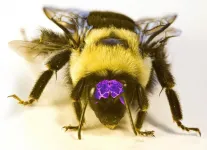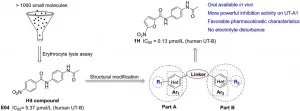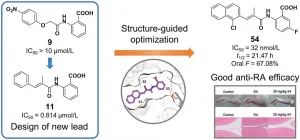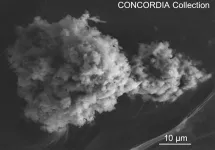The fastest one wins
Enantioselective synthesis of indole derivatives
2021-04-08
(Press-News.org) Indole, and structures derived from it, are a component of many natural substances, such as the amino acid tryptophan. A new catalytic reaction produces cyclopenta[b]indoles--frameworks made of three rings that are joined at the edges--very selectively and with the desired spatial structure. As a research team reports in the journal Angewandte Chemie, the rates of the different steps of the reaction play a critical role.
Indole derivates are widely distributed in nature; they are part of serotonin and melatonin, as well as many alkaloids--some of which are used as drugs, for example, as treatments for Parkinson's disease. Indole is an aromatic six-membered ring fused to a five-membered ring along one edge. The five-membered ring has a double bond and a nitrogen atom. The basic indole framework can be equipped with a variety of side groups or bound to additional rings. Indole and many indole derivatives can be made by an indole synthesis reaction developed by and named after Emil Fischer (acid-assisted condensation of ketones with phenyl hydrazines).
The most important class of indole derivatives are cyclopentane[b]indoles--molecules with a framework made of one indole unit and an additional five-membered ring. This five-membered ring can contain a chiral carbon center, which is a ring carbon that has two additional side groups, and it can be arranged in two ways that are mirror images of each other. Only one of the two enantiomers, or mirror images, is found in nature. However, the classic Fischer indole synthesis produces a mix of both enantiomers.
A team led by Santanu Mukherjee and Garima Jindal at the Indian Institute of Science, Bangalore (India) has now developed a catalytic version of the Fischer indole synthesis that primarily produces one of the enantiomers (i.e., the reaction is enantioselective). The starting materials are a class of diketones (2,2-disubstituted cyclopentane-1,3-diones) and phenylhydrazine derivatives equipped with special protecting groups. The secret of their success is a special catalyst: a chiral, cyclic phosphoric acid. The reaction is carried out in the presence of zinc chloride as a co-catalyst and an acidic cation-exchange resin, which captures the ammonia that forms as a byproduct.
The heart of the reaction mechanism is called a dynamic kinetic resolution. During the reaction, a chiral hydrazone is first formed as an intermediate in both enantiomeric forms. This step is reversible, so that both of the enantiomeric hydrazones can interconvert during the course of the reaction. The reaction of the hydrazones to make the indole derivatives is the actual catalytic reaction. This reaction is much faster for one of the hydrazone enantiomers compared to the other because one form has a more favorable geometry when binding to the chiral catalyst. The other hydrazone enantiomer reacts very slowly and leads to only a small amount of the indole product. Instead, the slow-to-react hydrazone enantiomer converts to the fast-reacting hydrazone enantiomer, causing the equilibrium to eventually shift to the product cyclopentane[b]indole.
This method made it possible for the team to produce many different indole derivatives in moderate yields, but with good to excellent enantiomeric selectivity.
INFORMATION:
About the Author
Dr. Santanu Mukherjee is an Associate Professor at the Department of Organic Chemistry of the Indian Institute of Science, Bangalore, India. His primary research interests revolve around the development of new catalytic enantioselective transformations.
https://orgchem.iisc.ac.in/santanu-mukherjee/
ELSE PRESS RELEASES FROM THIS DATE:
2021-04-08
Using a surprisingly simple technique, researchers in the University of Arizona Department of Neuroscience have succeeded in approximating how many brain cells make up the brains of several species of bees, ants and wasps. The work revealed that certain species of bees have a higher density of brain cells than even some species of birds, whereas ants turned out to have fewer brain cells than originally expected.
Published in the scientific journal Proceedings of the Royal Society B, the study marks the first time the new cell counting method has been applied to invertebrate animals and provides a robust and reproducible protocol for other research groups studying the brains of ...
2021-04-08
Discovery of novel diarylamides as orally active diuretics targeting urea transporters
Urea transporters (UT) play a vital role in the mechanism of urine concentration and are recognized as novel targets for the development of salt-sparing diuretics. Thus, UT inhibitors are promising for development as novel diuretics. In this study the authors discovered a novel UT inhibitor with a diarylamide scaffold by high-throughput screening. Optimization of the inhibitor led to the identification of a promising preclinical candidate, N-[4-(acetylamino)phenyl]-5-nitrofuran-2-carboxamide ...
2021-04-08
The full assembly of human chromosome 8 is reported this week in Nature. While on the outside this chromosome looks typical, being neither short nor long or distinctive, its DNA content and arrangement are of interest in primate and human evolution, in several immune and developmental disorders, and in chromosome sequencing structure and function generally.
This linear assembly is a first for a human autosome - a chromosome not involved in sex determination. The entire sequence of chromosome 8 is 146,259,671 bases. The completed assembly fills in the gap of more than 3 million bases missing from the current reference genome.
The Nature paper is titled "The structure, function and evolution of a complete chromosome 8."
One of several intriguing characteristics ...
2021-04-08
Using DNA structures as scaffolds, Tim Liedl, a scientist of Ludwig-Maximilians-Universitaet (LMU) in Munich, has shown that precisely positioned gold nanoparticles can serve as efficient energy transmitters.
Since the inception of the field in 2006, laboratories around the world have been exploring the use of 'DNA origami' for the assembly of complex nanostructures. The method is based on DNA strands with defined sequences that interact via localized base pairing. "With the aid of short strands with appropriate sequences, we can connect specific regions of long DNA molecules together, rather like forming three-dimensional structures by folding a flat sheet of paper in certain ...
2021-04-08
It's like something out of science fiction. Research led by Bigelow Laboratory for Ocean Sciences has revealed that a group of microbes, which feed off chemical reactions triggered by radioactivity, have been at an evolutionary standstill for millions of years. The discovery could have significant implications for biotechnology applications and scientific understanding of microbial evolution.
"This discovery shows that we must be careful when making assumptions about the speed of evolution and how we interpret the tree of life," said Eric Becraft, the lead author on the paper. "It is possible that some organisms go into an evolutionary ...
2021-04-08
Design, synthesis, molecular modeling, and biological evaluation of acrylamide derivatives as potent inhibitors of human dihydroorotate dehydrogenase for the treatment of rheumatoid arthritis
Human dihydroorotate dehydrogenase (DHODH) is a viable target for the development of therapeutics to treat cancer and immunological diseases, such as rheumatoid arthritis (RA), psoriasis and multiple sclerosis (MS).
The authors designed and synthesized a series of acrylamide-based novel DHODH inhibitors as potential RA treatment agents. 2-Acrylamidobenzoic acid analog 11 was identified as the lead compound for structure-activity ...
2021-04-08
Orchids of the Boreal zone are rare species. Most of the 28,000 species of the Orchid family actually live in the tropics. In the Boreal zone, ground orchids can hardly tolerate competition from other plants -- mainly forbs or grasses. So they are often pushed into ecotones -- border areas between meadows and forests, or between forests and swamps.
Furthermore, there has been a decline in wild orchids all over North America and Eurasia, caused in part by human-induced destruction of their habitats, the transformation of ecosystems, and the harvesting of flowers from the wild.
In the Novosibirsk region, ...
2021-04-08
Pioneering research led by experts from the University of Exeter's Living Systems Institute has provided new insight into formation of the human embryo.
The team of researchers discovered an unique regenerative property of cells in the early human embryo.
The first tissue to form in the embryo of mammals is the trophectoderm, which goes on to connect with the uterus and make the placenta. Previous research in mice found that trophectoderm is only made once.
In the new study, however, the research team found that human early embryos are able to regenerate trophectoderm. They also showed that human embryonic stem cells grown in the laboratory can similarly ...
2021-04-08
Every year, our planet encounters dust from comets and asteroids. These interplanetary dust particles pass through our atmosphere and give rise to shooting stars. Some of them reach the ground in the form of micrometeorites. An international program conducted for nearly 20 years by scientists from the CNRS, the Université Paris-Saclay and the National museum of natural history with the support of the French polar institute, has determined that 5,200 tons per year of these micrometeorites reach the ground. The study will be available in the journal Earth & Planetary Science Letters from April 15.
Micrometeorites have always fallen on our planet. These interplanetary dust particles from comets or asteroids are particles of a few tenths to hundredths of a millimetre that have passed ...
2021-04-08
Scientists have made a pivotal breakthrough in understanding the way in which cells communicate with each other.
A team of international researchers, including experts from the University of Exeter's Living Systems Institute, has identified how signalling pathways of Wnt proteins - which orchestrate and control many cell developmental processes - operate on both molecular and cellular levels.
Various mechanisms exist for cells to communicate with each other, and many are essential for development. This information exchange between cells is often based on signalling proteins that activate specific intracellular signalling cascades to control cell behaviour at a distance.
Wnt proteins are produced by a relatively small group ...
LAST 30 PRESS RELEASES:
[Press-News.org] The fastest one wins
Enantioselective synthesis of indole derivatives






